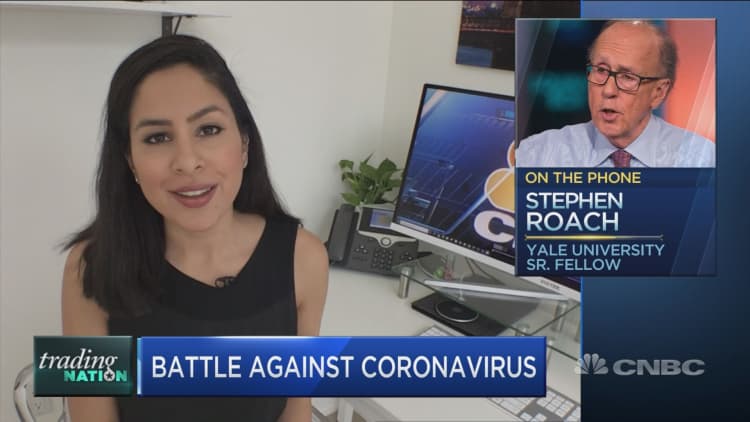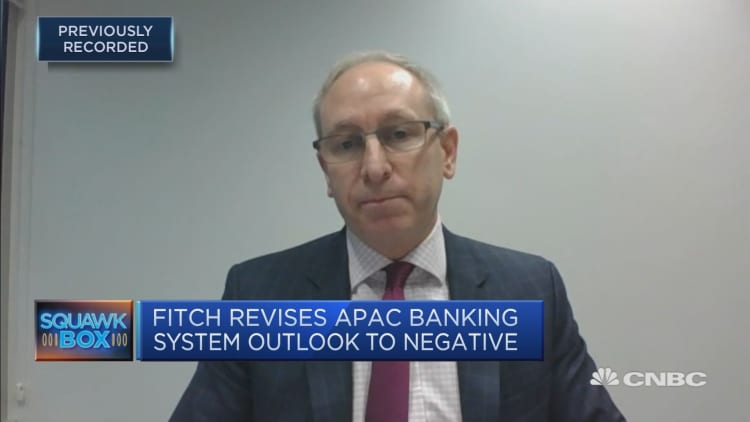With the worldwide economic turbulence wrought by the coronavirus crisis and nationally enforced lockdowns across major markets, global growth is set to be pushed toward zero, analysis from S&P Global Ratings predicts.
"In response to the ongoing extraordinary impact of the coronavirus pandemic on economic activity and financial markets, we have marked down global growth to just 0.4% this year, with a rebound to 4.9% in 2021," S&P's global chief economist Paul Gruenwald wrote in a research note published Tuesday. "The decline in activity will be very steep."
The dire 0.4% forecast would be a level the world hasn't seen since the economic crash of 1982, when global growth was calculated at 0.43%, at the time the worst financial downturn since the Great Depression of 1929-1933.
Before the coronavirus pandemic, S&P's forecast for growth in 2020 was 3.3%.
The third week of March revealed a staggering 3.28 million Americans filed jobless claims, more than four times the previous record of 1982. Lockdowns have forced businesses deemed non-essential to shut their doors, with billions of people worldwide staying indoors to self-isolate in an effort to slow the spread of the coronavirus, which has so far killed more than 38,700 and infected more than 800,000.
'Highly uncertain'
Fixed asset investment in China, the world's second-largest economy, fell 45% year on year, with industrial production and retail sales down by 14% and 21%, respectively, S&P reported. Capital is disappearing from emerging markets at a faster rate than any previous global crisis, and the S&P 500 is down 30% at a record speed — 22 trading days — while the VIX Volatility Index, also known as Wall Street's "fear gauge," hit its highest point since the 2008 financial crisis.

Regionally, sharply decreased forecasts for the U.S. and Europe are driving the majority of S&P's forecast to change, with expected contractions of 1.3% and 2%, respectively. The firm sees a 12% contraction in the U.S. over the second quarter compared to first three months of the year.
In the U.S., "Growth will likely rebound to 3.2% in 2021, implying a loss of GDP of $360 billion relative to our December 2019 baseline," Gruenwald wrote.
"Labor market outcomes are deteriorating sharply and the unemployment rate will likely top 10% in the second quarter (with a monthly peak above 13% in May)," he added, meaning more unemployed workers than in the wake of the Global Financial Crisis, which hit a peak of 10.2% in October 2009.

Emerging markets also played a major role in the forecast drop, the largest of that category being India with an expected contraction of 3.5%. India announced a mandatory 21-day lockdown for its entire population of 1.3 billion people on March 22. China's growth, already at a 30-year low of 6.1% for 2019, is forecast at 3% this year.
The ratings firm emphasized the unpredictable course of the disease itself, noting that it based its forecast for recovery on some government estimates that the pandemic will peak halfway through the year.
"The risks to our baseline forecast remain firmly on the downside since the translation from health outcomes to economic variables remains highly uncertain," the report said.
No consensus on when it will end
Central banks and governments have enacted enormous measures, knocking down interest rates and deploying trillions of dollars to spur economic stimulus and make cash available to people and businesses. But the spending and investment normally required to kick-start an economy is now impossible for most sectors, particularly high-employing industries like tourism and transportation, hospitality, entertainment, restaurants and retail.
"The federal government's $2 trillion fiscal package should cushion the downside by injecting money directly into households, extending unemployment benefits to 13 weeks, making money available to small and medium enterprises (SMEs), funding hospitals and local governments, and providing guarantees and subsidized business loans," S&P wrote of the U.S. economy.
While S&P's U.S. unemployment forecasts are high, they pale in comparison to some others — for instance that of the St. Louis Fed, which on Monday predicted total U.S. unemployment reaching as high as 47 million people, or a devastating 32.1% — higher than the Great Depression peak of 24%.
Much of the forecasting depends on the severity of the virus spread, when it might abate and when the world can return to normal. That is something scientists as of yet have no consensus on, but estimates among the health community are currently anywhere between two or three months to more than a year.


